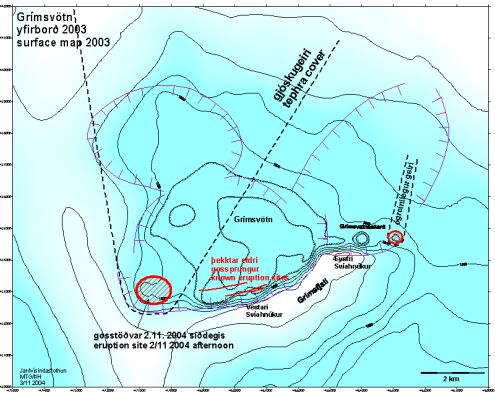NEWS 2001 - 2007
Dec
7 2007 - Tremors Cause Flood in Glacial River Skeidará
The Icelandic Meteorologist Office detected subterranean disturbances
near Grímsvötn lakes on Vatnajökull glacier,
south Iceland, on Wednesday night causing increased flow of water
and electrolytes in Skeidará river, leading from the glacier.
“Then
there is no doubt about it; Skeidará has started flooding,”
Gunnar Sigurdsson, hydrologist and engineer at the National Energy
Authority told Morgunbladid. “We expect this to be a large
flood.”
Once
the water level in Grímsvötn lakes has reached a certain
height it tunnels its way down through Skeidarárjökull
glacier, one of the southern arms of Vatnajökull, and into
Skeidará.
This
phenomenon is known as Skeidarárhlaup in Icelandic and
happens regularly. The last flood in Skeidará took place
three years ago and was followed by a volcanic eruption underneath
Vatnajökull.
The volume of water in Skeidará yesterday was comparable
to a good summer’s day and the smell of sulfur was in the
air on Skeidamerkursandur plains, through which the river flows
to the ocean.
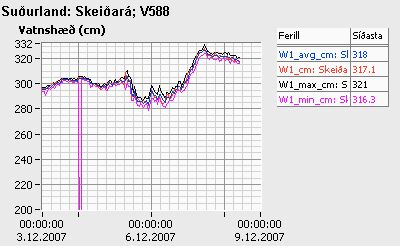
Nov
13 2007 - The sun rises late in October
Iceland Review is popular magazine in Iceland. They have made
audio slide show about journey in October from Reykjavik to Jokulsarlon.
Vatnajokull.com recomend this article
and click
on the picture and you wil see the story. Click
here.
Oct
13 2007 - Mountaineer to climb 100 summits in one year
The mountaineer Thorvaldur Thórsson has climbed Iceland's
100 highest summits. On Saturday Oct 13. He and his friends, about
80 people finished the last summit, Mt. Hekla. After three days,
he will celebrate his 50th birtday.
In
middle of June
having already summited 47 peaks. Thórsson climbed the
country’s five highest mountains in one day.
The
five highest mountains are all on Vatnajökull glacier: Káratindur,
Thurídartindur, Mikill, Heljargnípa and Mávabyggdir
and the total distance between them is 50 km, Morgunbladid reports.
“I had a good sleeping bag, an extra bag and a heating device,
so if I’d gotten into trouble I could have stayed on the
glacier. I had enough food, but the backpack was heavy during
the 50 km that I hiked,” Thórsson said.
The mountaineer was alone despite the danger of falling into a
crevasse in the glacier. He used skis for crossing the glacier,
which is safer than hiking by foot.
Thórsson,
who works as a computer scientist at Vistor hf., is an experienced
mountaineer and ice climber. He has been nicknamed “tindahöfdinginn”
or “the summit chief” because of his mission.
August
27 2007 - Missing Israeli tourist found alive
An Israeli tourist in her twenties, reported missing on Saturday,
was found alive yesterday in Hveragil ravine in Kverkfjöll
mountains in the highlands north of Vatnajökull glacier.
About 50 people had been searching for the woman.
Arna
Ösp Magnúsardóttir, the ranger in charge of
the cabin at Sigurdarskáli, found the woman. “She
left [the cabin] on Friday and planned to go on foot through Hveragil
and be back at noon on Saturday,” Magnúsardóttir
told Morgunbladid.
“When she didn’t return I started worrying and at 11
pm on Saturday I contacted the [112] Emergency Helpline,”
Magnúsardóttir said. “On Sunday morning I drove
into Hveragil and found the woman.” It takes about two hours
to drive from Sigurdarskáli cabin into the ravine.
Magnúsdóttir explained the woman had gotten lost
in fog on Friday and decided to wait in her tent by a trail until
someone found her, which, according to the ranger, was a wise
course of action.
The
woman was well prepared and in good shape, as she had spent the
summer hiking the northeastern part of the Westfjords, Hornstrandir,
and cycling around the central highlands.
August
27 2007 - Iceland’s commercial whaling put on hold
Minister
of Fisheries Einar K. Gudfinnsson announced this weekend that
no new quota will be issued for commercial whaling for the next
fishing season, beginning September 1, since the whale meat from
the current season remains unsold.
“I
don’t think it serves any purpose to issue new quota allowances
when nothing is selling,” the minister said, explaining it
has taken longer than planned to sell the fin whale meat in Japan,
Morgunbladid reports.
Seven fin whales and seven minke whales were caught during the
last fishing season, after Iceland resumed commercial whaling
last fall.
“We
know that there is interest for the meat in the Japanese market,”
Gudfinnsson stated, explaining several quality issues need to
be taken care of before the meat could be sold, which has taken
longer than planned. “But I’m sure the market will open
up. There is nothing in international laws that prohibits such
business.”
Gudfinnsson said the meat from the seven minke whales caught was
sold successfully on the local market.
Árni
Finnsson, head of the Iceland Nature Conservation Association,
celebrates the minister’s decision. “I think it is very
wise move. This way the minister puts the responsibility on the
whalers. They have to prove that there is a market for the product
in Japan.”
“Last year the minister believed they could export the meat,
but it didn’t work out that way. Now he is taking precautions,”
Finnsson said, adding that he doesn’t think there is any
market for the whale meat. “And then the game is over.”
August
27 2007 - Search for German tourists called off
Search
teams packed up and left Svínafellsjökull glacier
on Saturday night after having searched for two lost German tourists
since early last week. Search organizers are going to let their
teams rest and review the situation.
“We
are going to go through our documents and review the evidence
again to make sure we followed up on every lead,” Vídir
Reynisson, the representative of the Commissioner of the Icelandic
Police, who is leading the search expedition, told Fréttabladid.
Experienced
mountaineers have searched on and around Svínafellsjökull
glacier, a sub-glacier of Öraefajökull on Vatnajökull,
in the hills of Hvannadalshnjúkur, Iceland’s highest
peak, and Hrútafjallstindar peaks for the last few days.
On Saturday, almost 200 people searched in 23 groups from daybreak
until nightfall. A Coast Guard helicopter, TF-Gná, brought
the search teams up to the glacier to save time and searched by
air.
According to Reynisson, the area has been searched as thoroughly
as possible. “The teams have grown extremely tired and some
have hiked the glacier for four days in a row and searched for
hours at high altitudes. People need to rest before we continue."
The
two young German tourists, Thomas Grundt and Matthias Hinz, were
reported missing on August 17, but no one has heard from them
since the beginning of August. Their tents were discovered on
Svínafellsjökull glacier on Thursday, but since then
there has been no sign of them.
The case of the lost Germans has raised questions as to whether
tourists who hike in Iceland’s highlands are taking enough
precautions.
Ragnar Stefánsson, the park ranger in Skaftafell National
Park and leader of the emergency service Kári í
Öraefum, wants to obligate people who plan to hike Öraefajökull
glacier to submit a planned itinerary.
“Many mountaineers think it limits one’s sense of freedom,
but I think it demonstrates a certain level of curtsey towards
emergency services,” Stefánsson said.
Skaftafell National Park, the 112 Emergency Helpline, the Icelandic
Association for Search and Rescue (ICE-SAR) and several parties
within the tourism industry are preparing a brochure, after encouragement
from Stefánsson, with information about the dangers involved
in hiking Öraefajökull, recommending hikers submit a
planned itinerary to 112 before embarking on their journey.
At this time of year, there are many deep crevasses in the glacier.
August
25 2007 - Tents belonging to missing German tourists
Tents
belonging to the two German tourists, who have been missing in
Iceland since August 17, were discovered by the Coast Guard helicopter
TF Gná on Svínafellsjökull glacier yesterday,
a sub-glacier of Vatnajökull.
A
driver’s license belonging to one of the young men, Mattias
Hinz and Thomas Grundt, was found, confirming the tents were theirs,
ruv.is reports. According to police, the tents were in an odd
location.
A
Coast Guard airplane transported specially trained search teams
from the capital region to the glacier to take over the search,
including a special forces police officer and a tracking dog.
The
search area has been reduced considerably and is now limited to
Skaftafell National Park, west of Öraefajökull glacier
on southern Vatnajökull, to which Svínafellsjökull
belongs, and on the upper part of Öraefajökull.
The area that is being searched is difficult to cross and is dangerous
at this time of year.
August
24 2007 - Tents belonging to missing German tourists discovered
Tents
belonging to the two German tourists, who have been missing in
Iceland since August 17, were discovered by the Coast Guard helicopter
TF Gná on Svínafellsjökull glacier yesterday,
a sub-glacier of Vatnajökull.
A
driver’s license belonging to one of the young men, Mattias
Hinz and Thomas Grundt, was found, confirming the tents were theirs,
ruv.is reports. According to police, the tents were in an odd
location.
A
Coast Guard airplane transported specially trained search teams
from the capital region to the glacier to take over the search,
including a special forces police officer and a tracking dog.
The
search area has been reduced considerably and is now limited to
Skaftafell National Park, west of Öraefajökull glacier
on southern Vatnajökull, to which Svínafellsjökull
belongs, and on the upper part of Öraefajökull.
The area that is being searched is difficult to cross and is dangerous
at this time of year.
August
23 2007 - German tourists missing in Iceland
The
search for two young German tourists, Matthias Hinz and Thomas
Grundt, is still ongoing. Search teams were hindered by rain and
poor visibility yesterday near Skaftafell National Park in south
Iceland.
Fridrik
Jónas Fridriksson, leader of the Hornafjördur emergency
service, said search teams are concentrating on the area near
Skaftafell because the Germans may have been spotted there, Bladid
reports.
“Two
men matching their description were seen in the highlands, which
we are investigating. We have also been told they may have left
the region, but that hasn’t been confirmed,” Fridriksson
said.
A
group of search teams accounting for 40 people in total hiked
to Svínafellsjökull and Skaftafellsjökull glaciers,
sub-glaciers of Vatnajökull, which are considered dangerous
to cross.
Due to bad weather and another emergency involving tourists in
the central highlands, the Coast Guard helicopter was delayed
in joining the search.
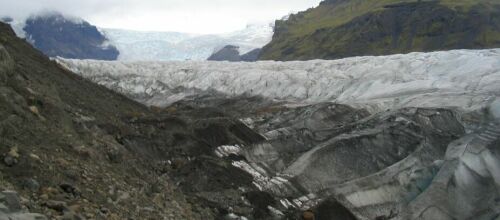
Seen
up Svinafellsjokull. The scene for Batman Begins film was there
2004.
June
21 2007 - Mountaineer to climb 100 summits in one year
The
mountaineer Thorvaldur Thórsson plans to climb Iceland’s
100 highest mountains this year, having already summited 47 peaks.
On Tuesday Thórsson climbed the country’s five highest
mountains in one day.
The
five highest mountains are all on Vatnajökull glacier: Káratindur,
Thurídartindur, Mikill, Heljargnípa and Mávabyggdir
and the total distance between them is 50 km, magazine
Útivera reports.
“I
had a good sleeping bag, an extra bag and a heating device, so
if I’d gotten into trouble I could have stayed on the glacier.
I had enough food, but the backpack was heavy during the 50 km
that I hiked,” Thórsson said.
The
mountaineer was alone despite the danger of falling into a crevasse
in the glacier. He used skis for crossing the glacier, which is
safer than hiking by foot.
Thórsson turns 50 next fall and hopes to finish his mission
by then. According to him, the most difficult mountains are already
behind him.
Next he plans to climb Mýrdalsjökull glacier, Hofsjökull
glacer or Kverkfjöll mountains. Thórsson said he hoped
that by the time he climbs the volcano Hekla, which most people
can climb, more hikers will join him.
Thórsson,
who works as a computer scientist at Vistor hf., is an experienced
mountaineer and ice climber. He has been nicknamed “tindahöfdinginn”
or “the summit chief” because of his mission.
June
14 2007 - Where the ice is blue
In
Iceland Reviw magazine Zoe Robert write about journey to Vatnajokull.
You can read the Daily
life article here.
June
10 2007 - Listen to Vatnajökull glacier melt
The
British artist Katie Paterson has made it possible for art lovers
to listen to Vatnajökull glacier, the largest in Iceland
and in Europe, melt with one phone call.
Paterson
became fascinated with glaciers on her travels to Iceland and
has now established a microphone in Jökulsárlón
lagoon at the foot of Vatnajökull, Fréttabladid reports.
Callers
can listen to rumbles when the glacier melts, breaks into pieces
and icebergs fall into the lagoon. The telephone number is +44-(0)7758-225698.
May
26 2007 - Tourist Association hikes to Iceland’s highest
peak
Over
100 hikers took part in the Icelandic Tourist
Association’s (FÍ’s) annual Whitsun trip
to Hvannadalshnjúkur, Iceland’s highest peak, on Saturday.
The group was split between 13 guides, who led the hikers up the
mountain slope.
Hvannadalshnjúkur
was hidden behind low hanging clouds and snowfall caused poor
visibility, but the hikers made it to the top anyway.
“It
is incredible to have achieved this and I believe many other first-timers
agree,” Erna B. Einarsdóttir, who hiked to Iceland’s
highest peak for the first time on Saturday, told Fréttabladid.
This
is the third time FÍ has organized a hike to Hvannadalshnjúkur
during the Whitsun weekend. According to Einarsdóttir,
more applied for the hike than in the last two years and the available
spaces were taken by the beginning of April.
Hvannadalshnjúkur is located on the north-western rim of
the Öraefajökull volcano on Vatnajökull glacier
in southeast Iceland. The peak is 2,109.6 meters high.

April
10 2007 - Glaciers in Iceland melting “faster than ever”
Oddur
Sigurdsson, an Icelandic geologist who has undertaken studies
of Iceland’s glaciers, said the nation’s glaciers are
melting at record speed and may disappear completely after 200
years due to global warming.
“It
is obvious judging by the data that we have that it is first and
foremost caused by the heat in summer, which has increased considerably,
especially in the last ten years,” Sigurdsson told RÚV.
Sigurdsson
said he believed global warming is the gravest problem the human
race has ever faced.
French
geologist Jean-Marc Bouvier, who has undertaken studies of the
Greenland ice cap, explained to RÚV that once the Arctic
glaciers have disappeared the ocean surface will be nine meters
higher than today and flood an area which is currently inhabited
by one billion people.
Bouvier
described this situation as a “meteorological time bomb”
and said “the wick has already been lit.”
April
4 2007 - Leanordo DiCaprio and Knut on Jokulsarlon. Cover page
May issue of Vanity Fair.
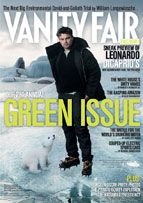 |
Leanoardo
DiCaprio and polar bear Knut were filmed at Jokulsarlon in
march and covers the Green issue of Vanity
Fair. |
March
19 2007 - Largest national park in Europe
Before
the parliament in Iceland closed on Saturday, MPs agreed to found
a national park at Vatnajökull glacier, which will be the
largest national park in Europe.
All
political parties agreed on founding the park, which will be called
Vatnajökulsthjódgardur, or Vatnajökull National
Park, and is scheduled to open next summer. Fréttabladid
reports.
Vatnajökull
National Park will cover 1/8 of Iceland’s surface and include
the current Skaftafell National Park and Jökulsárgljúfur
National Park.
Minister
of the Environment Jónína Bjartmarz announced that
she was very pleased with the decision on Saturday
Jan
25 2007 - Marine technology used on glaciers
Rescue
services in Iceland are experimenting with a different type of
technology to locate people lost on glaciers, a radar that is
normally used for locating ships at sea.
The
rescue services get dozens of calls every year reporting lost
drivers of snowmobiles and jeeps, who were traveling on glaciers,
and it is of vital importance to locate them as soon as possible.
RÚV reports.
Vilhjálmur
Árnason, the managing director of Sónar ehf., which
specializes in sailing equipment, said: “Snow and water have
many things in common. Both glaciers and the ocean have even surfaces,
so vehicles are easy to locate [using the radar].”
Test
runs on the glacier have proved successful. “We can locate
jeeps at a two-kilometer distance and snowmobiles at a one-kilometer
distance. That surpasses my expectations,” Árnason
said.
Thór
Thorsteinsson, a member of the rescue service Ok (which is also
the name of a glacier that once existed in west Iceland), said:
“Visibility on glaciers is often poor because of drifting
snow or fog and people often get lost in that kind of weather.
With this technology we can search a much bigger territory with
one car.”
Oktober
22 2006 - Whaling is affecting tourism
Already
there are signs of whaling affecting tourism in Iceland negatively.
Iceland’s government decided to resume commercial whaling
last Tuesday.
Heimir Hardarson, marketing director of whale watching company
Nordursiglingar in Húsavík, northeast Iceland,
says tourists have already started canceling trips to Iceland.
|
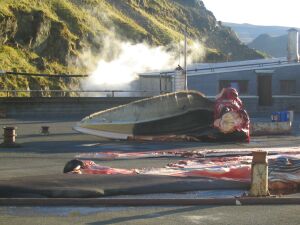 |
Hardarson told Fréttabladid last night that his business
is clearly being affected by Iceland’s decision to resume
commercial whaling after a 17 year ban.
Last summer almost 30,000 tourists went whale watching with Nordursiglingar.
The first whaler set out to sea on Tuesday, but has not caught
any whale yet.
René Baldinger of Swiss travel agency Baldinger Reisen
AG sent a written statement to icelandreview.com yesterday, expressing
his concerns about Iceland resuming whaling.
Baldinger says: “Already today a few customers called us
to see if this was really true. There are enough alternative destinations
to go to.”
Minister of Environment Jónína Bjartmarz says whale
hunting could have a negative impact on Iceland’s image.
She says she worries about the country’s credibility. This
is reported in all the main media.
Bjartmarz says there are arguments for and against whaling and
that whaling is without a doubt sustainable. She says people’s
views about whaling are often based on misunderstandings.
Iceland’s decision to resume commercial whaling has gotten
worldwide attention. Helgi Ágústsson, Iceland’s
ambassador in USA was interviewed on CNN last night, where he
explained the government’s reasons for making this decision.
June
25 2006 - New York Times finds the "ultimate road trip"
in Iceland
In
an article published in the New York Times last weekend, 18. June,
Mark Sundeen describes a journey around Iceland on road number
1, commonly known as the "hringvegur" or the Ring Road.
In an article titled "Ultimate Road Trip", Sundeen describes
the landscape as "sublime and melancholy" and imagines
that "this was how it felt to drive California's coast 75
years ago, downshifting on the sharp bends in the gravel road,
idling before a one-lane bridge while an oncoming car made its
crossing."
Sundeen concludes: "I could have stayed there forever."
Link
to New York Times
May
10 2006 - Höfn
The
three-tongued glacier has begun to melt.
What will we do, they ask, when boulder-milt
Comes wallowing across the delta flats
And the miles-deep shag ice makes its move?
I saw it, ridged and rock-set, from above,
Undead grey-gristed earth-pelt, aeon-scruff,
And feared its coldness that still seemed enough
To iceblock the plane window dimmed with breath,
Deepfreeze the seep of adamantine tilth
And every warm, mouthwatering word of mouth.
The
poet Höfn by Seamus Heanys in the new poetry book District
and Circle.
See article in The
Guardian.
May
5 2006 - DirPedia.com
- combining a dictionary, an encyclopedia and a web directory
tells us from Vatnajökull.
Vatnajokull
is the largest glacier in Iceland. It is located in the south-east
of the island, covering more than 8% of the country. With a size
of 8,100 km², it is the largest glacier in Europe in volume
and the second largest (after Austfonna + Vestfonna on Nordaustlandet,
Svalbard) in area. The average thickness of the ice is 400 m,
with a maximum thickness of 1000 m. Iceland's highest mountain,
Hvannadalshnjúkur (2,110 m), is located in the southern
periphery of Vatnajökull, near Skaftafell National Park.
It is classified as an ice cap glacier. Under the glacier, as
under many of the glaciers of Iceland, there are some volcanoes.
The volcanic lakes, Grímsvötn for example, were the
sources of a large glacier run in 1996. The volcano under these
lakes also caused a considerable but short-time eruption in the
beginning of November, 2004. Vatnajökull has been shrinking
for some years now, possibly because of climatic changes and recent
volcanic activity.
April
22 2006 - Skaftá in Iceland floods. Tourists warned on
Sulfur Contaminationy
Skaftá,
one of the rivers south of Vantajökull glacier started flooding
this morning. The Civil Protection Department has issued a warning
that tourists should be aware that the sulfur level in the air
is dangerously high. You can smell the sulfur in the beginning
but when the level is dangerously high the smell disappears.
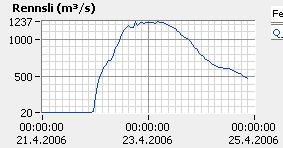 |
The
flood started this morning and at 15.00 the water has increased
considerably but nowhere close to what is expected at peak
level. The flood had been expected by experts and they think
the flood will be at its peak within two days. |
March
3 2006 - Record temperatures in February
Reykjavík
experienced the warmest February since 1965 last month, reports
daily Morgunbladid. The average temperature in the capital measured
3.3 degrees -- 2.9 degrees above average February temperatures.
According to the Icelandic Meteorological Office, it was the fourth
warmest February since 1866 when meteorological measurements started.
1932 and 1965 saw substantially higher temperatures. In 1964,
it was just a little warmer and in 1929 the temperature was approximately
the same as this year.
Precipitation
was also above average in southern and western Iceland last month,
measuring 87mm, 20% over average precipitation.
The
sun shone for 58 hours in Reykjavík last month, six hours
above average.
The
lowest February temperatures this year were at the glacier Brúarjökull,
- 25.8 degrees, while Seydisfjördur experienced the highest
temperatures, 16.2 degrees.
Februar
20 2006 - Earthquakes in Bardarbunga
Earthquakes,
the largest reaching 2.9 on the Richter scale, were registered
in Kistufell (1.444 m) near Bardarbunga.
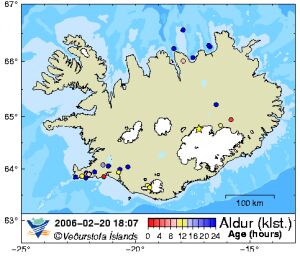
Yellow star in north part of Vatnajokull shows eartquake.
Oktober
20 2005 - The Brúarjökull Project: Sedimentary environments
of a surging glacier
Fast
flowing ice or palaeo-ice streams have recently been identified
as one of the most important controls on the configuration and
stability of former ice sheets. The problem, however, is the lack
of contemporary analogues for land based ice streams that is necessary
to understand their glacio-dynamic behaviour. Despite this, a
certain type of glaciers (surging glaciers) that momentarily reaches
fast ice flow actually provides an imprint of sediments, landforms
and landform assemblages that resembles the situation related
to ice streams. The overall aim of the Brúarjökull
project is directed towards the study of depositional environments
at a contemporary surging glacier. This includes the development
of glacial landscapes and associated sediments. Thus, it embraces
the interaction between climate-processes-sediments and landforms
over time and space involving glaciological, geomorphological,
sedimentological and glacial geological disciplines. The results
will serve as reference work and inspiration for geomorphological
and geological investigations in areas suspected to be influenced
by palaeo-ice streams. Reconnaissance work was carried out during
the 2003 field season, continued field work was in the Brúarjökull
glacier forefield area in 2004, and is planned for the 2005 summer,
with an international research team comprising up to 10 members.
Project
description by Kurt Kjær and Ólafur Ingólfsson
August
29 2005 - Shrinking Icelandic glaciers
In
the last ten years Snæfells Glacier has retreated at a fast
pace due to warmer weather and shrunk a great deal reports
Morgunbladid.
"The weather is always getting warmer and the glacier is
not as beautiful as before," said Leifur Ágústsson,
a farmer in Mávahlíð in
Snæfellsbæ. He said crevasses that one did not see
before can now easily be seen from far away.
Tryggvi
Konrádsson, owner of Snjófells, a travel service
at Arnarstapa, agreed with Leifur, and said that the edge of the
glacier has
retreated. He said that he is not worried and that "it will
snow again".
According
to a geologist from the Energy Institute, Oddur Sigurdsson, Icelandic
glaciers have shrunk rapidly in the last decade. He said
that this was especially evident on Snæfells Glacier, a
glacier which had been growing for over 25 years.
"There has been a lot of snow on the mountain in the past,"
said Oddur, "now we just see the bare glacier."
He
said that there is no need to worry, the glacier is not about
to disappear even though temperatures continue to rise. Oddur
explained that because of the retreat, the glacier is not advancing
as much as before, therefore new crevasses are less likely to
form. He
said that the older crevasses become more visible when the snow
covering them melts. Oddur also said that glaciers are usually
most
dangerous to traverse when they are growing but one should always
be cautious. Source: http://www.icelandreview.com
July
19 2005 - Protestors Arrested at Dam Site
Eighteen
protestors succeeded in stopping work for over two hours yesterday
at the site of the controversial Kárahnjúkar hydro-electric
development in East Iceland. The river is Jökulsá
á Brú, coming from Brúarjökull one of
Vatnajokull's small glaciers. The protestors entered the work
area and chained themselves to trucks and other equipment or lay
in front of vehicles. The police from nearby Egilsstaðir arrested
13 protestors, who offered no resistance. The remaining five had
left by the time police arrived. Ómar R. Valdimarsson,
spokesperson for Impregilo, the main contractors at Kárahnjúkar,
said that charges will probably be laid.
Birgitta Jónsdóttir, one of several other protestors
at a camp site near the hydro-electric project, said that Icelanders
did not take part in this particular demonstration, although everyone
was staying at the same camp. “Everyone is here on his or
her own volition, and personally I have nothing against action
of this kind as long as lives are not put at risk”.
June
3 2005 - Archaeologists discover 14th century farm
“It
is as if the buildings had been abandoned yesterday” says
archaeologist Bjarni F. Einarsson in Morgunblaðið today.
The farm he and his colleagues recently discovered was buried
under ash in an eruption in glacially capped volcano, Öræfajökull.
At 2111 meters, Öræfajökull is Iceland’s
highest mountain, sticking out of the southeast corner of Iceland’s
largest glacier, Vatnajökull.
The farm is close to the town of Fagurhólsmýri and
was laid waste in an eruption in 1362. There had long been rumors
of an abandoned farm in the Fagurhólsmýri region,
and in 2001 Bjarni and his team started surveying the area. The
excavation started last summer and the archaeologists soon traced
the outlines of several houses. This spring, they have continued
their work, mapping out the detailed structure of each dwelling.
When
the excavation is completed, the local archaeological society
plans to turn the site into a landmark open to visitors.
May
3 2005 - Whale watching bomb!
The
.com bomb is over but the Whale bomb is still active in Iceland.
The whale watching tours started in Höfn, In The Realm Of
Vatnajokull, by Glacier Tours company. In following table you
can see the growth in whale watching in Iceland.
|
|
Place
|
WWC
|
Pers.
|
|
1990
|
1
|
1
|
6
|
|
1991
|
1
|
1
|
100
|
|
1992
|
0
|
0
|
0
|
|
1993
|
1
|
1
|
150
|
|
1994
|
3
|
4
|
200
|
|
1995
|
6
|
8
|
2.200
|
|
1996
|
8
|
9
|
9.700
|
|
1997
|
10
|
13
|
20.540
|
|
1998
|
8
|
12
|
30.330
|
|
1999
|
7
|
10
|
35.250
|
|
2000
|
9
|
12
|
44.000
|
|
2001
|
10
|
12
|
60.550
|
|
2002
|
10
|
12
|
62.050
|
|
2003
|
10
|
12
|
72.200
|
|
2004
|
10
|
12
|
82.000
|
Source:
Björgvinsson, 1999; Hoyt, 1994b; Hoyt, 1995a; Data from SI.
|
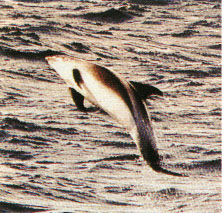 |
December
2004 - Eruptions in Vatnajokull from 1902
The eruption in Vatnajokull in November was number 13 from 1902.
Over 50 eruptions have occured in Vatnajokull since Iceland was
settled in the year 874. Source: THE ICELANDIC METEOROLOGICAL
OFFICE
| 2004 |
Grímsvötn |
| 1998 |
Grímsvötn |
| 1996 |
Gjálp |
| 1983 |
Grímsvötn |
| 1954 |
Grímsvötn |
| 1945 |
Grímsvötn |
| 1938 |
Grímsvötn |
| 1934 |
Grímsvötn |
| 1933 |
Grímsvötn |
| 1922 |
Grímsvötn |
| 1910 |
Þórðarhyrna |
| 1903 |
Þórðarhyrna |
| 1902 |
Grímsvötn |
November 16 2004 - Amazing Race - the sixth edition
The sixth edition of THE AMAZING RACE began in downtown Chicago
as Teams made their way to Reykjavic, Iceland. Race in rural Icelandic
landscape. Drive vehicles to Seljalandsfoss waterfall to find
theri nest clue behind a torrent of water. Then to Vatnajokull,
biggest glacier in Europe.
 |
A
Detour is a choice between two tasks, each with its pros and
cons. In this Detour, Teams had to choose between Ice Climb
and Ice Search.
More story about the Amazing
Race |
November
6 2004 - Vatnajokull's eruption Ceasen
The volcano at Grímsvotn ceased today (Saturday). Seismic
activity stopped on Friday, and the last emissions were observed
early today. The eruption began on Monday, November 1.
A fly-over after the eruption revealed a new caldera in Grímsfjall
mountain.
November
5 2004 - Small activities in eruption in Grímsvötn
The volcanic eruption at Grímsvötn is still going,
though activity is easing
Picture
from Science Institute University of Iceland - Magnus Tumi.
November
4 2004 - Eruption in Grímsvötn Continues
The volcanic eruption at Grímsvötn is still going,
though activity is easing today. Seismic activity today measured
3.3 on the Richter scale, down from 3.7 two days ago, when activity
was first measured.
Ash
from the volcano has travelled as far as Finland.
November
1 2004 - Eruption in Vatnajokull
A volcanic eruption occurred on Vatnajokull glacier, at 20:10
local time. The exact location of the eruption was Grimsvotn,
which is on the western portion of Vatnajokull, Europe's largest
glacier
The
eruption peaked at 3.7 on the Richter scale and continued through
the evening. Visual confirmation was impossible, as heavy rain
and winds of up to 20 mps limited visibility in the area.
The
Meteorological Office issued warnings to aircrafts to avoid the
gasses emitted from the volcano at 22:00 local time. No evacuations
were necessary.
The
eruption is believed to have been caused by expansion of a lake
underneath the Vatnajokull glacier.
"The
water is under extreme pressure from the glacier. We believe it
could open a part of the Grimsvotn mountain side, causing the
release of some magma, though this can not be confirmed without
visual identification," explained Oli Thor Arnarsson, Forecaster
on duty at the Meteorological Office.
Grimsvotn
last erupted six years ago. It also erupted in 1996 and 1993,
causing flooding in the largely uninhabited area.
| Grimsvotn
lies on the Atlantic Rift, the meeting of the Euro and American
continental plates. The three major volcanoes of Iceland,
Hekla, Katla and Grimsvotn lie on the same fault line. Hekla
last erupted in 2000. |
Oktober
31 2004 - Flood in Skeidara
The Skeidará River has been flooding for the last two days.
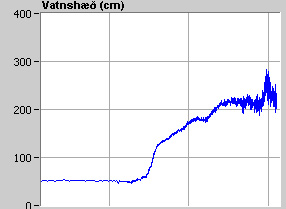 |
A
high-tech measuring device has been placed in the river and
it was this that announced the beginning of the flood. The
flood is bigger than 2002. |
September
12 2004 - Skaftafell National Park, biggest national park in Europe
Former environment minister, Siv Friðleifsdóttir showed
the world in Skaftafellsstofa, Visitor Centre in Skaftafell, new
and bigger National Park.
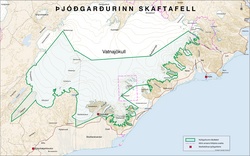 |
The
new Skaftafell National Park is 4.807 km2 and covers 57% of
Vatnajökull ice-cap and Laki area. This is first step
in progressing the whole ice-cap and surrouinding in Vatnajokull
National Park. |
September
11 2004 - 22.000 kilos iceberg from Jokulsarlon to Paris
On September 27, an Icelandic exhibiton start in Paris. An 22
ton iceberg was transfered from Jökulsarlón and will
be placed in front of
Palais de la Découverte. Name of the show is: Islande,
de glace et de feu.
Islande,
de glace et de feu est la plus grande manifestation culturelle
islandaise jamais organisée en France.
Du 27 septembre au 10 octobre 2004 la culture islandaise sera
à l'honneur à Paris et en régions.
Islande, de glace et de feu est un voyage au cœur d'un pays
qui interpelle notre imaginaire.
3 thèmes forts se dégagent de la programmation de
cette quinzaine culturelle:
-Raison
et déraison, sciences et nature:
-Avant-garde
et création dans les domaines de la musique et des arts
plastiques.
- Une
exploration des sources de l'Imaginaire islandais, pays des sagas
et des elfes par le biais de l'histoire, de la littérature,
du cinéma et du théâtre.
Offical
web site: Islande
de glace et de feu
August
14 2004 - Beowulf and Grendel
Icelander to begin filming Beowulf and Grendel.
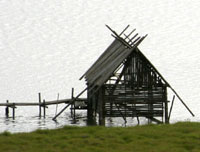 |
Icelandic/Canadian
director Sturla Gunnarsson will start production for the live
action film of the ancient poem Beowulf. The filming will
begin on the 16th of August. Gerard Butler and Icelandic actor
Ingvar E. Sigurdsson will play in the movie as the warrior
Beowulf and his nemesis Grendel respectively. Also appearing
will be Canadian actress Sarah Polley. |
The
film will be made on location in Iceland near Höfn and Vik
and, according to Sturla, will not use any digital effects as
many movies of recent years have done when recreating epic battles.
The story of Beowulf is said to have had a major influence on
the writings of J.R.R. Tolkien, author of the Lord of the Rings
trilogy.
Offical
web site.
March
15 2004 - Cameron Smith crossing Vatnajokull
Cameron
Smith, professional archaeologist based in Portland, Oregon, USA
started crossing Vatnajokull in begining of March. He has 30 km
left today and has got bad wether in last day's.
His goal is to make a solo winter 'round-trip' crossing of the
Vatnajokull Icecap, Iceland. He will travel on ski, pulling a
sledge loaded wth food and equipment. He started on the West side,
ascend to the 1,500m (roughly one-mile)-high ice plateau, cross
the plateau to the East side, descend, and then turn around to
retrace steps and return to starting point, a round-trip journey
of roughly 320 km miles (c.200 miles). Here is his offical website.
March
3 2004 - Batman Begins
The
fifth Batman movie is currently being filmed in Iceland. The film
crew counts around 200 people and among the actors are Michael
Caine, Morgan Freeman, Liam Neeson Katie Holmes and Christian
Bale. Bale and Neeson are already in Iceland. A spokesman for
the producers will not disclose where the filming is actually
taking place, but they are neaer national park Skaftafell and
glaciertounge Svinafell in south-east Iceland
Jan
31 2004 - Tourists in Iceland 2004
The
Icelandic Travel Industry Association estimate
350.000 tourist to Iceland on this year. It is about 30.000 more
than last year.
Okt
21 2003 - Whales and Tourists
Iceland’s
six-week, scientific whaling programme did not have a major effect
on tourism. In the short run there was a negligable effect, but
that it wouldn’t last.
The government’s whaling prorgamme ended last month. On the
last day of September the 36th and last minke whale where culled
during the government's scientific whaling programme. The original
quota called for whalers to cull 38 minke whales. 36 is enough
to conduct experiments. The Institute plans to conduct various
experiments on the whales, from testing whale tissue for pollutants
to hormonal research conducted by marine biologists.
Over the first seven months of 2003, tourism in Iceland has increased
by 12 per cent from last year.
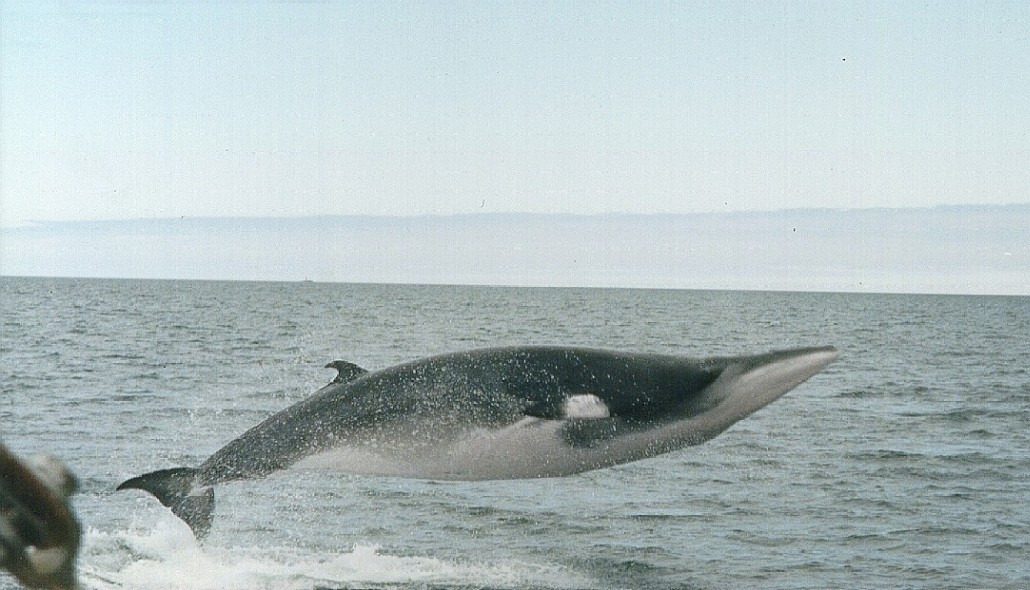
Aug
21 2003 - Minke Whale Research
According
to Gísli Víkingsson, project director for the minke
whale hunt, the animals caught in August and September will be
researched very carefully. The main aim of this research is to
aquire knowledge on the “food ecology” of minke whales
off the Icelandic coast. Samples will be taken from their digestive
system, and blood and tissue samples will be taken to investigate
diseases and the amount of pollutants in different organs. The
two whales caught already have been used in this way. Says Víkingsson,
“This is the most thourough research ever done on whales.“
The minke whales are dissected on the whaling boat and the samples
are taken to Reykjavík. The whale meat, however, goes on
the market, in accordance with the rules of the IWC, which say
that the meat of hunted whales should be used.
Aug
18 2003 - Iceland Kills First Minke Whale
The
crew of the whaling vessel Njördur killed its first whale
for the Icelandic government’s “scientific whaling”
programme, which was launched last Sunday, according to Iceland’s
Marine Research Institute.
According to the Institute, Njördur, one of three whaling
vessels issued government permits to hunt whales, killed the first
of 38 minke whales that are to be culled over the next six weeks
Samples have already been taken from the whale and sent to a laboratory
to determine what food the whale eats, if it has a concentration
of pollutants, and overall health.
The Icelandic government has said that it’s necessary to
measure the whales’ effect on the surrounding fish stocks.
The
hunt, which is taking place amidst protests from environmental
groups and many foreign governments, including the US which has
threatened possible sanctions against Iceland, marks the first
time that whales have been culled in Icelandic waters since the
government put a moratorium on whaling in 1989
Jun
23 2003 - Largest Lobster Yet
The
largest lobster ever caught in Iceland was nabbed off the south
coast, Skeiðarárdýpi, sout of Skaftafell National
Park. The beast measured 46 cm in length from tail to claw, and
weighed 411 g. The tail was 81 mm. Its claws alone were 27 cm
long. Proud fishing trawler Thorsteinn GK-16 made the catch.
| In
next weekend The Lobster festival is in Höfn. Lobster
is very important in this town. The festival started in 1993.
The biggest festival was in 1997 when the town Höfn was
100 years old. About 4000 extra people celebrated. |
 |
Jun
10 2003 - Whale Embryo in Húsavík
The
Whale Centre in Húsavík received a whale embryo
last year as a gift and recently the embryo has been put on display
in a glass case. Formaldehyde was injected into the embryo, and
the seawater in the case also contains three per cent formaldehyde.
The embryo is from a minke whale, which beached at Höfn in
Hornafjördur last year. The specimen is 150 centimetres long
and weighs around 40 kilos.
Nov
22 2002 - James Bond film - Die Another Day
 |
The
James Bond film, Die Another Day was released in UK on Nov.
20 and in US two days later. Part of the film was filmed in
Iceland on frozen ice lagoon at Jokulsarlon. We have got many
visits and requests
because of the film.
"You are now famous in the UK" was in one e-mail. |
Nov
19 2002 - Bárðarbunga (Bardarbunga) shrinking
Several earthquakes, the largest reaching 3.1 on the Richter scale,
were registered in Bardarbunga.
Okt 21 2002 - Öræfajökull shrinking
Several earthquakes, the largest reaching 3.9 on the Richter scale,
were registered north of Öræfajökull glacier (part
of Vatnajökull glacier, southeast Iceland), west of the Esjufjöll
Mountains, around 3 AM this morning.
According to Ragnar Stefánsson, seismologist at the Icelandic
Meteorological Office, this area is closely related to the volcanic
system of Öræfajökull glacier, but slightly north
of the main volcano. Stefánsson added that Öræfajökull
glacier is known for its volcanic activity, and that eruptions are
quite common there.
The largest of its four recorded eruptions occurred in 1362; all
have been destructive, owing to the devastating floods caused by
melting ice. In 1727 was the second eruption sinch Iceland was settled
874. Its highest peak, Hvannadalshnúkur (6,950 ft/2,119 m),
is also the highest point in Iceland.
Sept
24 2002 - Vatnajokull shrinking
On average, Vatnajökull glacier is receding 37 cm per year,
reports glaciologists from the Geoscience Society of Iceland.
Scientists state that since 1995, Vatnajökull, Europe’s
largest glacier, has lost up to one per cent of its entire mass.
This average has been computed from data collected on the glacier
since 1996.
Since 1995, the glacier has shrunk 5 m in water volume, says Finnur
Pálsson, a scientist from the University of Iceland.
“If we look at the past decade, it appears that the glacier
is 2.7 m thinner than it was in 1992, with measurements based
on water volume,” Pálsson said.
“But there is no reason to be worried about the glacier thawing
out, because it’s normal for glaciers to vary in their size
from year to year,” he added.
Sept
20 2002 - Flood In Skaftá River
The flood from the glacial river Skaftá is slowly decreasing.
The river crested yesterday morning at 650 cubic m/s. This morning
it had decreased to 521.2 cubic m/s. Normally running at 50 cubic
m/s and it can take up to two weeks for the river to reach its
normal level.
Sept
15 2002 - Water Rich
Plans to profit from the exportation of Icelandic water have failed,
despite the fact that Iceland has the largest supply of fresh
water per capita in the world. Reports indicate that each year,
Iceland has 666,667 cubic meters of water available per person.
This is 50 per cent more than the Republic of the Congo, which
is in second place.
A liter of drinkable water can go for up to ISK 40 on the international
market.
July
12 2002 - Flood Fears
Scientists
from the UK have detected signs of unusual geothermal activity
beneath two different glaciers in Iceland, reported ‘BBC
News Online’ yesterday.
On
the western edge of the Vatnajökull glacier, the scientists
have discovered two deep depressions, while beneath Mýrdalsjökull
glacier (south-central Iceland), increased seismic movements have
been recorded, a possible indicator of a volcanic eruption.
The
scientists told ‘BBC News Online’ that there is little
threat at present, but that they cannot predict how the activity
on the different glaciers may develop.
July
8 2002 - Glacial Flood Reaches Its Maximum
Earlier
this morning the flood from the glacial river Skaftá reached
its maximum, at 06.50 in Sveinstindur mountain. At that time the
flow was measured at 647 cubic metres per second. It is estimated
that the flow running near inhabited areas will reach its maximum
between 19.00 and 20.00 tonight.
At this time it is still not certain whether the flood comes from
the larger (eastern) or smaller (western) kettle in the western
part of Vatnajökull glacier. It is, however, considered most
likely that the flood is runing from the smaller one. This can
only be confirmed by flying over the glacier and investigating
it carefully.
The last flood from Skaftá glacial river was in the year
2000 when two floods came, one from each kettle, all within one
week.
April
15 2002 - Humpback whale beached
A
humpback whale beached last night near the shore at Ósland
in Hornafjördur. It is thought likely that the whale followed
a shoal of capelin into the mouth of the river, which is very
shallow. At 22.00, fishermen had managed to put a rope around
the whale’s tail and tried to tow him into deeper water.
The whale was very weak and all their efforts to tow it away were
in vain. The whale died this morning.
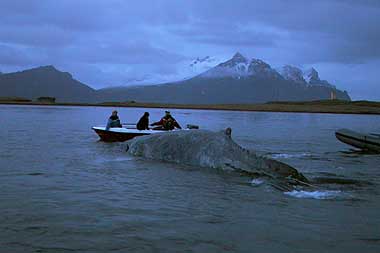 |
The
whale was 12 meters long and provided two and a half tonnes
of meat. The meat was free of charge to whoever wanted it,
as it is forbidden to sell the meat of a stranded whale. |
April
14 2002 - Flood in Skeidará River
The
Skeidará River has been flooding for the last few days
and reached its maximum flow yesterday at 630 cubic metres per
second. The river, situated in southeast Iceland, floods every
year due to geothermal activity in the Vatnajökull glacier,
at the Grímsvötn lakes.
A
high-tech measuring device has been placed in the river and it
was this that announced the beginning of the flood. The National
Energy Company intends to place more devices such as this around
the country.
March
7 2002 - Earthquakes in Myrdalsjökull
This
year, over 600
tremors have been registered on Myrdalsjökull glacier,
south Iceland.
According to Erik Sturkell, a geologist at the Icelandic Meteorological
Office, this increased activity does not signal changing geological
patterns.
March
6 2002 - "James Bond 20" on Jokulsarlon
 |
Crew
of 200 people have been filming part of next James Bond film
which will be relesed in November 22. This project takes 3
weeks. |
January
28 2002 - Sand storm on Myrdalssandur
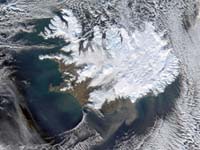 |
This
image was taken on January 28, 2002 and show sandstorm on
Skeidararsandur.
There is snow on north, east and on highland, but south west
part is without snow.
Photo: nasa |
January
16 2002 - Vatnajokull Shrinks
Iceland’s,
and Europe’s largest glacier Vatnajökull is shrinking.
According to glaciologist Helgi Björnsson, the glacier has
receded by one metre per year in the last two years due to little
snow and a warmer climate. Björnsson expects another metre-thick
layer of ice to disappear this year.
Vatnajökull
is 400 metres thick on average, reaching 900 metres in some parts,
but according to Björnsson, it could take much less than
400 years for it to disappear. “If this evolution continues,
the country’s glaciers will look pretty miserable by the
end of the century.”
January 10 2002 - Bond on Ice - "Bond 20" filmed In
The Realm Of Vatnajokull Glacier
Location
scouts working for the production company for the 20th ‘James
Bond’ film have expressed interest in Iceland. However, initially
the interest
arose not in the island’s striking landscape, but in its
rescue helicopters.
Locations under consideration include the area around the Jökulsárlón
glacial lagoon and the Skálafellsjökull glacier.
January
9 2002 - Weekly Flights between Egilsstadir and Düsseldorf
A
contract was signed yesterday on the launch of weekly flights
between
Egilsstadir in east Iceland and Düsseldorf, Germany. The
contract was
signed by German airline LTU, travel agency Terra Nova-Sól
hf, The
Iceland Tourist Board, the East Iceland Development Bureau and
the East
Iceland Tourist Board.
LTU
will begin flights on 7 June and will fly weekly until 30 August
to and
from Egilsstadir airport. They will be using a 180-seater Airbus
plane and
have agreed to market the flights in Germany for a budget of 10
million
krónur. LTU plans to offer flights from Munich to Egilsstadir
in 2003 and
from Munich to Akureyri, north Iceland, in 2005.
It means you can go direct to Vatnajokull glacier from Egilsstadir.
January
8 2002 - Flood in Jokulsa aFjollum
At
7 pm secure system alerted flood (480 m3/s) had started in Jokulsa
a Fjollum. The water came from Kverkfjoll in Vatnajokull.
September
25 2001 - Extensive flooding in south-east Iceland
The
river Súla and the Núpsvötn lakes near the
Vatnajökull glacier in south-east Iceland have been extensively
flooded. A group of geologists
flew over the area yesterday and confirmed that the floods are
from Grænalón lagoon (18 sq.km) an ice-dammed lake
at the glacier. The river smells strongly of sulphur which is
unusual and geologists are doing further research.
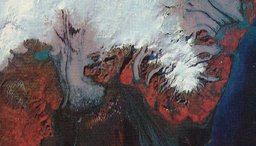
The floods this year are the largest since 1986 and we don't know
why there
is so much sulphur in the water.
September 11 2001 - Snæfellsjökull Shrinks
The
glacier Snæfellsjökull, in west Iceland, made internationally
famous in the Jules Verne novel ‘Journey to the Centre of
the Earth’, is shrinking at a steady rate. According to Helgi
Björnsson, scientist at The University of Iceland, the reason
for this shrinking is the lack of snow in recent years.
“This process is getting faster and faster. If the weather
continues as it has in the last five years, most of the large
glaciers will have been greatly reduced at the end of this century
and the smaller ones will have disappeared.“
June 19 2001 - 'It was magic' Lara Croft: Tomb Raider
Part
of the film Lara
Croft:Tomb Raider was filmed on Vatnajokull and Glacial Lagoon
last year. Star of the film Angelina Jolie said:
"So
she worked to turn herself into Croft. That meant lifting weights,
shooting heavy guns, paddling canoes, jumping with bungee cords
and riding a dogsled. The movie took her from the chill of Icelandic
glaciers to the tropical beauty of Cambodia's Angkor Wat.
The travel in particular, said Jolie, broadened her horizons.

"Iceland was amazing -- being on a glacier the size of Wales
and going with dogs on amphibious vehicles into this water, that
-- if you fall into it -- you've got about four minutes to live,"
she says." -
Angelina
Jolie as Laura Croft in Tomb Raider on CNN web
May 28 2001 - GLACIER EXHIBITION At Höfn.
In
the Southeast at the town of Höfn, with horizons dominated
by glacial ice, an exhibition on glaciers has now been set up,
crowned by the magnificent neighbour Vatnajökull. Here knowledge
of glacial properties and their effects on the environment and
society gains focus and comes alive through the help of selected
scientists, scholars and artists. Presentations include informative
boards of text and pictures, photographs, a movie, artwork and
instruments old and new, all relating to glaciers. In fact, the
exhibit spreads through the entire district, with indicated stops
where one can observe evidence of glacial activity.
We hope that all our guests will enjoy and learn from their visit.
Natural science, cultural information, arts, lectures every second
tuesday, store with souvenirs and quality Icelandic crafts.
Open daily 10 am - 6 pm June, July and August. More
info here
April 19 2001 - Breidarmerkurjökull has recessed 2 km from
1973.
Images
from Landsat 1 on September 22, 1973 and Landsat 7 on September
23, 2000 show the almost two kilometer (1.2 mile) recession of
the Breidamerkurjökull over the 27 year period. It means
Jokulsarlón is increasing. See more http://www.gsfc.nasa.gov/GSFC/EARTH/iceland/glacier.htm
March
11 2001 - More earthquakes in Bardarbunga
Earthquake
registering 2,6 on the Richter Scale was detecte at 18.21 P.M.
New period of eart quakes is starting.
February
2001 - Vatnajokull National Park
Next
year, 2002 is the year of the mountains and because of this event
the Governent of Icelnad will declear Vatnajokull ice-cap and
it's area, The Vatnajokull National Park. Our popular television
newsman Ómar Ragnarsson has suggested to call the new national
park "Íseldagardur" or "Ice and Fire park".
He think it will be better than Vatnajokull National Park for
marketing reasons.
February
25 2001 - Earthquake in Bardarbunga
Earthquake
registering 3.0 on the Richer Scale was measured In The Realm
Of Vatnajokull, on Bardarbunga at 04:18 a.m.
January 29 2001 - Big Tremor
A tremor registering 3.4 on the Richter Scale was measured in
the Vatnajökull Glacier area at one a.m., during the night.
According to Þórunn Skaftadóttir, geologist
at the geology department of the Icelandic Meteorological Institute,
the tremor was recorded six kilometres east of Hamarin, in the
western part of the glacier.
In
the daily Morgunbladid, Skaftadóttir commented that
it is common for there to be small tremors in this area, but
this (most recent) tremor was stronger than usual. She added
that there were no tremors detected yesterday during the day,
and that last night’s tremors do not necessarily mean
that there are bigger tremors to come.
Skaftadóttir
added that this most recent tremor should not cause alarm
since the nearest buildings were far away.
|
















